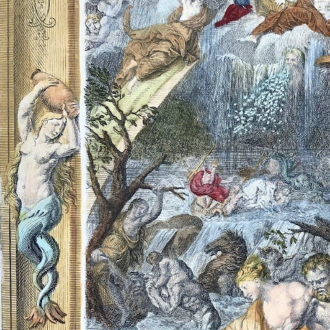


Polish artistic printmaking has a rich heritage and exceptional diversity of techniques, from woodcut to aquatint. According to Stanisław Stopczyk's definition, artistic printmaking is "a work created by printing a composition from a prepared plate," which allows for the creation of a series of copies. The average number of prints is about 56, of which 50 are intended for sale, while the remaining 6, marked as épreuve d’artiste, remain in the artist's possession as keepsakes or trial prints.
Due to the wealth of graphic techniques in Polish art, specific names referring to the techniques are used, such as aquatint, etching, linocut, and drypoint. The choice of material is also crucial, including woodcut, copperplate, steel engraving, and lithography. This category also includes works that combine drawing with printmaking, such as monotype or mezzotint, as well as cliché-verre, which combines photography and printmaking.
Polish artistic printmaking began to develop in the 19th century, particularly due to Jan Feliks Piwarski, who influenced the growth of Polish lithography. In the 1830s, Piwarski, an outstanding Polish artist, contributed to the popularization of this technique, which quickly found its place in the art market in Poland. The 1860s saw further development, especially in woodcut techniques, thanks to the Polish woodcutter Wincenty Smołkowski.
The 1870s were a time when Polish printmaking gained recognition abroad. The engravings of Antoni Oleszczyński and aquatints of Jan Lewicki achieved international acclaim, solidifying Polish artistic printmaking on the European scene. These techniques, requiring precision and patience, became essential elements of contemporary Polish art.
The turn of the 19th and 20th centuries marked the birth of so-called interpretative printmaking in Poland. This form of presentation transferred painted works into the world of black-and-white artistic printmaking, aiming to convey the emotions and perspectives of the creator. Feliks Jasiński, Ignacy Fałat, and Antoni Kamiński are artists who contributed to the development of this form, distinguished by their originality and ability to transform the images of master painters into graphic works of art. Jasiński created melancholic landscapes using aquatint, etching, and woodcut techniques, showcasing complex landscapes that strongly resonated with viewers.
In the early 20th century, Polish artists such as Józef Pankiewicz and Konstanty Brandel introduced a new quality to Polish printmaking by experimenting with aquatint and drypoint. Pankiewicz, in particular, was a master of drypoint and etching, creating works full of subtlety and precise details. Konstanty Brandel enriched Polish artistic printmaking with mysterious architectural motifs, infused with symbolism and depth.
However, true mastery was achieved by Leon Wyczółkowski, an outstanding Polish lithographer, who elevated the lithographic technique to a new level. His experiments with etching, aquatint, and fluorotype brought him fame and inscribed his name in the history of Polish artistic printmaking. According to Stopczyk, "in the work of Leon Wyczółkowski, lithographic technique reached new heights," making him one of the most important Polish artists in the history of this technique.
Polish poster art emerged from lithographic traditions, and the first Polish posters were created by outstanding painters, including Józef Mehoffer, Wojciech Weiss, and Teodor Axentowicz. Inspired by various movements, from expressionism to cubism and symbolism, Polish artists created a unique style. The vivid, expressive posters of Tytus Czyżewski attracted attention with their dynamism and innovative solutions.
Other creators, such as Edmund Bartłomiejczyk, Tadeusz Gronowski, and Tadeusz Trepkowski, favored a simpler, more minimalist form that perfectly aligned with the modernist trends of the 1920s and 1930s. Thanks to their work, Polish posters gained international recognition and became one of the strongest currents in Polish artistic printmaking.
In the 20th century, artistic woodcut became one of the most significant elements of Polish graphics, largely due to the efforts of Władysław Skoczylas. Skoczylas, creator of the "Zbójnicka Teka" and "Podhalańska Teka," was also the founder of the Ryt group, which promoted Polish artistic printmaking internationally. This group included prominent Polish artists, such as Edmund Bartłomiejczyk and Władysław Wąsowicz, who drew inspiration from local folk art, blending it with their unique styles.
As a teacher, Skoczylas educated a new generation of Polish printmakers. His students, including Stanisław Ostoja-Chrostowski, a master in the field of exlibris, and Bogna Krasnodębska-Gardowska, continued his style, developing artistic woodcut techniques and giving them new significance.
Polish artistic printmaking, with its wealth of techniques, continues to inspire contemporary creators. Today, Polish artists often return to classic techniques such as aquatint, woodcut, or lithography, contributing to their revival and giving them a new, contemporary expression. The legacy of Polish printmaking, built by outstanding artists like Wyczółkowski and Skoczylas, not only inspires but also solidifies Polish graphic art on the international stage.
Polish artistic printmaking is not only a history of techniques and tools but also a rich heritage of creativity that continues to attract art lovers and collectors from around the world.